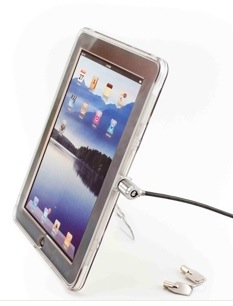A sleeper Apple innovation that has just been published by the US Patent & Trademark Office regards a more universal electronic device connector. See http://macte.ch/hpQ8C .
The history of Apple electronic connectors comes from the old 50 connector serial ports of 20 years ago to the tiny Lightning connectors found on the newest iPhones, iPads and iPods. The new connectors are now found on the opposite end of an USB cable that charge the device and allows the computer and iOS device to “talk.”
Remember the old days when computer connectors were the half the size of a Big Mac hamburger? The personal computer industry, including Apple, sort of took its lead from the wired telecommunication tech of the day. The old cables used 25-pair twisted copper wire used in office telephone systems, along with the giant connectors that were screwed down to the computer interface block. Heaven help your computer if you tried to remove or connect the cable if the computer was powered up. The sparks and smoke normally indicated a wasted mother board.
The tiny new Lightning iOS connector has the wonderful advantage of being reversible. Ever tried to hook up your iPad or iPhone to its charging cord in the dark? Statistically, 50% of the time you ought to get it right. It is my karma to be wrong 90% of the time as I fumble in the dark.
Having the correct orientation shown only with a tiny printed logo on the upper side of the connector was certainly one of Steve Jobs’ more anal and frustrating “it has to be symmetrical at any cost” design-over-function errors. A bump, groove or hole in the upper side of the connector would have given users a clue as to the correct orientation for the connector to slip into the iOS device. Some third party cable manufactures did this, but not Apple.
Not only has the previous connector been phased out to relieve users of the frustration cited above, the new connector is so much smaller it allows slimmer iOS devices. With all the whining about obsoleting legacy third party devices, the new connector is well worth the fuss. Some experts think the Lightning connectors may be with us for the next 10 years, so get over it.
The new connector relies on a proprietary chip hidden in the cord to allow the reversible connector to determine its current orientation and hook up the eight little connectors found on both side of the jack to the correct pin in the USB port. The third party cord manufacturers are busy trying to reverse engineer the chip. Otherwise, a dumb version of the Lightning connector wouldn’t work if it was inserted wrong and might well burn something out.
Apple has not only used a proprietary chip, they patented it to prevent competition from using their technology. Apple has been working to manage the third party devices with a program for approving accessory devices. Time will tell whether they intend to allow the Apple accessory industry to manufacture cords and adapters or not. icensing could also include other smartphone companies.
The future of connectors might well be wireless for both the interface with the computer and even the charging circuit. A coil on the back of an iPhone or iPad would allow another coil in a charging mat to power the battery up. Such charging devices are already being sold and adopted by some of the competition.
Personally, I don’t have a problem with plugging my new iPhone in to its cord. I just wish my six-month old iPad had the new connector.
That is Greg’s Bite.




